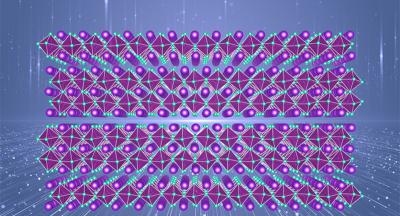Both ferromagnetic and ferroelectric materials are widely used today, and can coexist together in so-called multiferroic compounds, which can be traced back to the 1950s. Their use in modern technology has seen a recent resurgence as multiferroic compounds are energy-efficient and could be used in information storage devices for computers, servers, and hard drives.
Working with researchers from Kyoto University in Japan, Northwestern Engineering’s James Rondinelli discovered the first all-inorganic halide perovskite-derived multiferroic material, exhibiting a form of ferroelectricity called hybrid improper ferroelectricity which is also coupled to magnetic properties. In the past, studies of multiferroic compounds had been largely limited to transition metal oxides, yet many other materials classes can exhibit this phenomenon.
“The discovery of new types of materials, as well as a novel controlling mechanism, will facilitate device engineering based on multiferroic materials, potentially accelerating the industrialization of commercial electronics designed from halides,” Rondinelli said.
The team reported the findings in two related papers (links attached). This research was supported by the National Science Foundation and SUPREME, one of seven centers in JUMP 2.0, a Semiconductor Research Corporation (SRC) program sponsored by the Defense Advanced Research Projects Agency (DARPA).
The researchers figured out how the unexpected sequence of changes in the atomic structure and magnetic order respond to changes in temperature, which provides the necessary understanding to create new ways of controlling certain magnetic and electrical properties simultaneously.
The one of the research papers, highlighted in Nature Materials, led to the discovery of more materials with unique magnetic and electrical properties in halides. Initially, the team tried to replace certain elements in the materials they studied to find more materials with ferroelectric properties guided by principles used in the oxide community; but they realized that the way these halides behave couldn't be explained by the theories used for oxides. They came up with a new model that can explain how both halides and oxides behave, also showing that some of the halides promise to maintain their electric polarization and special properties in ultra-thin films, which is important for making smaller electronic devices. With such new model, a room-temperature multiferroic material was predicted to show a persistent electric polarization and strong coupling between the ferroic orders.
Uncovering the first all-inorganic halide perovskite multiferroic material through iterative experimentation guided by computation led to three major discoveries. The team found that new perovskite multiferroics can be designed from halides, beyond conventionally considered oxide materials. They also showed that multiferroic behavior can be thermally controlled by changing the temperature of the compounds, lending additional ways to modulate the multiferroic response beyond conventional electric and magnetic fields. Finally, they proved that layered halide multiferroic perovskites offer a chance to unambiguously realize magnetoelectric coupling between the ferroelectricity and ferromagnetism, which has been more difficult to establish at reasonable temperatures during past research into oxides.
“This work will help in the design of high-performing multiferroic devices, potentially attractive for companies who aim to exploit magnetoelectricity in scalable spintronic logic devices that operate on quantum mechanical effects combined with magnetoelectric switching, which our materials can provide,” Rondinelli said. “This discovery is expected to stimulate the discovery of new non-oxide multiferroics, broaden the understanding in the field, and facilitate the development of practical devices that operate at lower voltages and their miniaturization. This would enable mobile devices to require less frequent charging with current battery technologies.”
Identifying halide perovskite multiferroics opens a new avenue toward non-oxide-based multiferroic materials with promising physical properties not usually occurring in their oxide counterparts.
“This work can be further extended to other functional inorganic materials with other anion species, which are currently dominated by oxides,” Rondinelli said. “Additionally, the fact that temperature-control appears as a new stimulus for multiferroic control implies other previously less explored stimuli, such as ultrafast radiation, could potentially achieve similar multiferroic control, significantly broadening the research in multiferroics.”
Looking ahead, the team plans on studying whether other types of materials, such as sulfides, can show similar novel physical behaviors.




